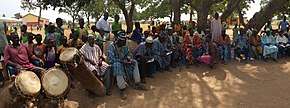Safaliba language
A recent project has developed a writing system for the language in order to enable its use in adult education and early school instruction. The Safaliba writing system is based on the work (1996) of Edmund Kuŋi Yakubu, a Safaliba teacher and activist[3]; a few changes in that system were made by Paul and Jennifer Schaefer, based on their phonological work, but the writing system for the most part stayed the same. [4] Safaliba audio recordings have been documented, transcribed, and discussed in Sherris, Schaefer, and Aworo (2018). [5]
| Safaliba | |
|---|---|
| Native to | Ghana |
Native speakers | 4,000 (2003)[1] |
| Language codes | |
| ISO 639-3 | saf |
| Glottolog | safa1243[2] |

Safaliba is a Gur language of Ghana.
An introduction to Safaliba for adult beginners can be found at this link: https://jarasahara.tumblr.com/
A social media page on Safaliba literacy activism in Mandari, Ghana, can be found at this link: https://www.facebook.com/SafalibaLiteracy/
References
- Safaliba at Ethnologue (18th ed., 2015)
- Hammarström, Harald; Forkel, Robert; Haspelmath, Martin, eds. (2017). "Safaliba". Glottolog 3.0. Jena, Germany: Max Planck Institute for the Science of Human History.
- Writing & Pedagogy,"Talk to Text Safaliba Literacy Activism: Grassroots Ghanaian Educational Language Policy" Volume 9, No 1, 2017,
- Learning to Read in Safaliba Helps Ghanaian Kids Learn English," 1 May 2015
- Sherris, A., Schaefer, P., & Aworo, S. M. (2018). The paradox of translanguaging in Safaliba: A rural indigenous Ghanaian language. In A. Sherris and E. Adami (Eds.), Making Signs, Translanguaging Ethnographies: Exploring Urban, Rural, and Educational Spaces, pp. 152-169. Bristol, UK: Multilingual Matters.